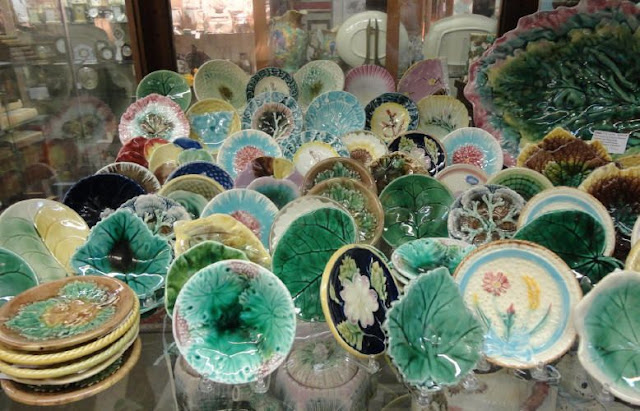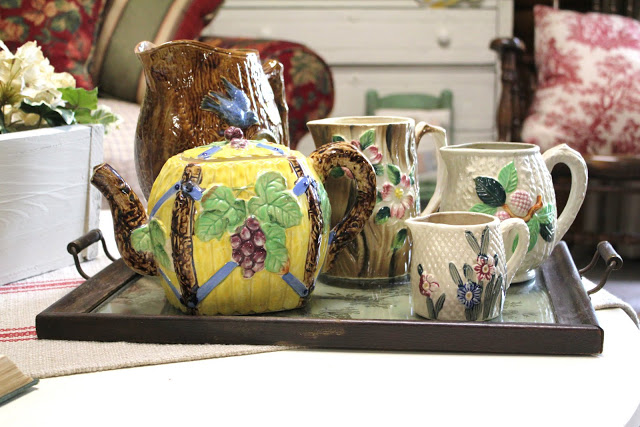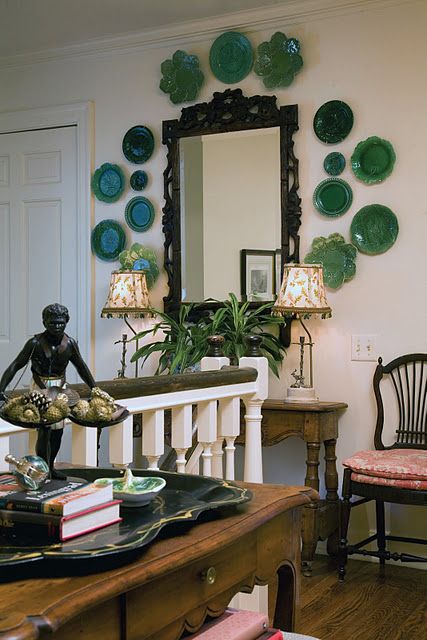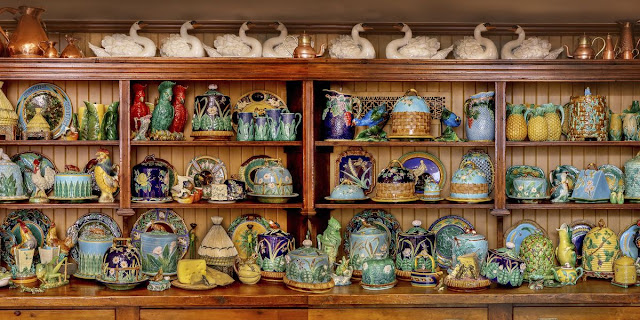Majolica is a term applied to Italian pottery originating during the Renaissance period of the 1400s-1500s in southern Europe. Majolica actually came to Italy via glazed products from Spain which were shipped from the port of Majorca. By the late 15th century several small cities in northern and central Italy were producing colorful majolica pieces for wealthy clients in Italy.
In 16th century France, self-taught French potter, Bernard Palissy, reformulated the Renaissance tin glazes and began decorating majolica serving pieces with odd creatures such as snakes, lizards and crustaceans. The French called it Palissy ware.
About 1850, Herbert Minton of the famous English porcelain factory began imitating the process used by Palissy. Minton first displayed majolica to the public in London at the Crystal Palace Exhibition of 1851 and as they say "the crowd went wild". The name majolica replaced Palissy ware and soon colorful majolica would be mass-produced in Britain, Europe, and the US. Only the advent of Art Nouveau ended the majolica trend and it's popularity did not return until the 1980's which was when I had my collection.
Even though I sold my collection I still admire these fun, colorful, and appealing pieces of majolica and would encourage anyone to consider collecting a few. Majolica is definitely a little kitsch and certainly not serious art. However you could say its warmth, whimsy, and decoration is worth the trouble. It is FUN!
via Pinterest
Majolica is a great way to add color and vibrancy to any interior space. But beware....many are addicted to majolica and there is little chance for recovery.
via Pintrest
There are so many wonderful and varied Majolica items to collect. From pitchers, teapots, and cheese dishes, to serving pieces and jardinières, the list goes on and on.
Majolica is a soft-bodied earthenware, distinguished by the use of a lead glaze to which tin ashes have been added, that accepts a variety of colors - blues, greens, yellows, oranges, and purples.
Believe me you will definitely find something of interest to collect in the majolica line. Most people just collect it all!
images via Pinterest
Majolica was at its height of popularity from the 1850's through the mid-1880's. Colorful majolica designs had rustic motifs with backgrounds of basketry and foliage decorated with rose stems and twined flowers, vines, and leaves. Handles were made like rustic tree branches. Fanciful birds, fish and animals adorned unexpected places.
Throughout England, highly decorated and texturally pleasing majolica objects were the perfect complement to a Victorian home’s décor. Today it is sought after again for the modern English style interiors.......but thankfully is held in restraint.
The combination of Victorian romanticism and naturalism provided the incentive for creating elements of the natural world in majolica ceramics.
Kinderhook Auction Company
Leaf themed majolica pieces are probably the most popular for collectors because of their affordability although some an still be expensive.
via Pinterest
More colorful, fanciful Majolica. Any piece adds texture and character to your interior.
Karen E Keysar Interiors Inc
Majolica From Trilogy Antiques
These botanical themes still delight and amaze collectors. Butter pats are fun small items to collect.
skinnerinc.com
These majolica pieces became a big hit with the socialites during the Victorian collecting frenzy.
I especially like French Barbotine majolica which has more of a dimensional look. Usually flowers, fruits, and animals would be applied separately from the body and covered with majolica glazes. The one piece I kept from my collection is Barbotine and is a basket with flowers and cherries attached.
Images via Pinterest
The French were particularly adept at this kind of trompe-l'oeil decoration and used it extensively on majolica.
George Jones & Sons
The majolica pitchers and vases with leaves, ferns and vines are great containers for charming floral arrangements.
Some majolica was influenced by the design of the old "Cauliflower" teapots made by Thomas Whieldon, Wedgwood, and other 18th-century Staffordshire potters. Both English and American majolica potters reproduced the "Cauliflower" pattern as well as other raised fruits and vegetables.
Turn of the century French majolica asparagus pieces were trendy then and are highly popular today as well.
Charles Darwin’s, On The Origin Of Species By Means Of Natural Selection, also fueled the fascination with the natural world during the Victorian era. Here in designer Alberto Pinto's home you can see his collection of lizard, snake, crustaceans and fish plates and platters that were all the rage at the time.
There was a boom in naturalistic pottery, often with an element of whimsy, to which colorful majolica was well suited.
Victorian majolica collecting became an interior design statement. Conservatories were becoming fashionable and they were adorned with spectacular majolica garden seats, flower pots, jardinières, large birds and animals figures. Majolica was EVERYWHERE!
all images via Pinterest
But the Victorians could not restrain themselves and left a plethora of majolica animals scratching their heads as to why nobody wanted them anymore. The Victorians (as was typical) had overdone the majolica trend and some of the wares created during this time eventually became thought of as tacky. By the death of Queen Victoria in 1901, majolica production was at an end.
The 1980's revival saw many of us being introduced to majolica and the treasure hunt was on again for this colorful collectible. We treated it much classier that the Victorians but it was eventually replaced by minimalism.
Today's collectors masterfully arrange majolica groupings in beautiful cupboards.
via Pinterest
NancysDailyDish (@nancysdailydish) on Instagram:
Look at all the beautiful colors!
Majolica pairs well with English Staffordshire figures.
See my blog on Staffordshire at https://eyefordesignlfd.blogspot.com/2019/01/decorating-with-english-staffordshire.html
Designer Margaret Chambers
Small vignettes throughout the home is a lovely way to display your majolica collection.
Another way to display a majolica collection is by hanging it artfully on a wall.
Many collectors are partial to greenware. This refers to the green glaze on this style of majolica that emphasizes the low relief patterning, typically of basketwork and foliage.
A charming greenware majolica collection artfully displayed in a Charles Faudree interior.
Be sure to use your majolica for special occasions as it will cast it's spell on your guests. Don't keep collections behind closed doors!
Majolica From Trilogy Antiques
One of the reasons colorful majolica serving pieces are fun to collect is how you can use them to liven up a mismatched party table.
via Pinterest
Bunny Mellon's majolica collection via The Glam Pad
via Pinterest
Antique French Sarreguemines Majolica. This style majolica was produced in the factories under the direction of Alexandre de Geiger during the 1830's in Sarreguemines which is a town in eastern France.
What a delightful majolica display!
Designer Linda Horn's majolica collection via veranda.com
For some reason dark browns and greens always come to mind when majolica is first mentioned. However most pieces exhibited pretty colors in shades of aqua, pink, yellow and blue.
via Pinterest
via Pinterest
Imaginative and magical, majolica is an amusing collectible. You never know what you might discover next.
Colorful pitchers are on the top of my list when it comes to collecting majolica. They are perfect for collections and equally appealing used individually in vignettes.
via Pinterest
French majolica vase with applied morning glory flowers and 5 birds.
There are lovely reproductions out the so you can collect antique, reproduction, or a combination of both and create an eye catching space in any room of your house. In any collection, there should be a balance of pieces from high to low quality, diverse in shapes, colors and makers. You might pick up treasure or two by keeping an eye out for it when you are thrifting or at estates auctions and yard sales.
Source unknown....please let me know if it is yours!
And the reproductions include it all from flowers and leaves to curious fish, fruit, and other living critters. The bottom line is to collect what YOU like because then you will never be disappointed.
Here are some tips if you are interested in collecting majolica.
REAL majolica was made in the 15th Century , $$$$$$, so forget about that. But it enjoyed a renaissance of its own in the 19th Century, where it graced fashionable Victorian homes. These pieces can still be found at reasonable prices if you get out and treasure hunt. And, of course, it’s still being made today. It is OK to collect the newer pieces just be aware that many reproductions are being passed off as vintage or antique. Just don't want you paying antique prices for reproductions!
1. Check the handles. Real antique majolica handles were applied on the outside. There should be no holes on the inside of the piece that reveal a hollow handle. Look beneath the handle on the outside, as well – some reproductions try to sneak in the firing hole, hoping you won’t notice.
2. Look inside. Even if the color doesn’t extend all the way to the bottom, the interior should be completely glazed.
3. Look on the base. A number can be a good thing.
4. Check out the crazing, (a network of fine cracks on the surface of a material, for example in a glaze layer). Some reproductions have tried to copy the crazing that comes from age and exposure to temperature changes. The repro crazing always looks too uniform and does not have that aged look.
Click here to see the previous post
This blog post was published by Lisa Farmer
In the event that I have not credited the correct source of an image, please contact me at lisafarmerdesigns46@yahoo.com and I would be glad to correct it.

















































